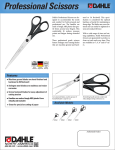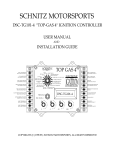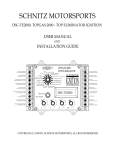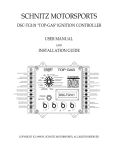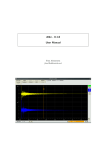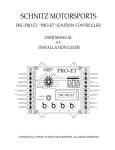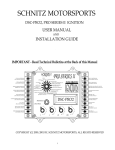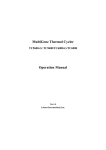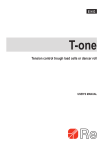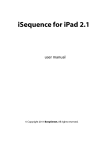Download ACCESSORY BELT DRIVES
Transcript
CHRYSLER SERVICE MANUAL ACCESSORY BELT DRIVES—1 Section IV ACCESSORY BELT DRIVES CONTENTS Page Accessory Belt Drives Torque Method 1 Accessory Belt Drives Belt Deflection Method 3 Service Diagnosis 3 DATA AND SPECIFICATIONS TORQUE METHOD Torque (ft.-lbs.) to be applied to Components. ACCESSORY USED BELT NEW BELT LC-1 LC-2, 3, LY-1 LC-1 Power Steering Bracket** 80* 75 120* 125 Idler Bracket 25 — 40 — Generator—Without Air Conditioning... With Air Conditioning 35 40 35 40 50 70 50 70 LC-2, 3, LY-1 BELT DEFLECTION METHOD Deflection (inches) to be applied at midpoint of belt segment under a five-pound load. (See Fig. 3) ACCESSORY USED BELT LC-1 Power Steering** X,* Vs % % Fan Belt-Idler Generator—Without Air Conditioning... With Air Conditioning NEW BELT LC-2, 3, LY-1 LC-1 LC-2, 3, LY-1 — Hi — X Hi Hi Hi *LC-1 with Air Conditioning only. '*On early production power steering pumps with bolt-on pulleys use the following torques and deflections. TORQUE DEFLECTION Used Belt New Belt 45 70 Used Belt New Belt 2—ACCESSORY BELT DRIVES CHRYSLER SERVICE MANUAL Section IV ACCESSORY BELT DRIVES SERVICE PROCEDURES The satisfactory performance of the belt driven accessories depends on the maintenance of the proper belt tension. If the specified tensions are not maintained, belt slippage may cause engine over-heating, lack of power steering assist, loss in air conditioning capacity, reduced generator charging rates, and greatly reduced belt life. To avoid any such adverse effects, the following service procedure should be followed: Retighten all belts to the specified used belt* tension at new car preparation. Retighten all belts at the 2,000 mile check up. Check all belts by the deflection method at servicing and retighten if needed. The new belt tension specifications should be used on all belt replacements, and the above procedure followed thereafter. The two methods by which belt tensions can be properly established is as follows: ened by inserting the torque wrench in the square hole provided in the bracket as shown in Figure 2. Other belts can also be tightened by this method if the adjusting bracket has a square hole. To tighten belts by the torque method, loosen all mounting bolts and apply the specified torque to the accessory or idler. Tighten all mounting bolts while the torque is apllied to the accessory. If it is not possible to use the torque wrench because of clearance, use an extension. 1. TORQUE METHOD All generator and power steering pump belts can be tightened to the specified tension (see specifications in this section) by use of a torque wrench. The generator belts are tensioned by using Tool C-3379 and torque Wrench as shown in Figure 1. The power steering belts are tight- 58x186 Fig. 2—Tightening Power Steering Belts using Square Hole TORQUE WRENCH Fig. 3-Belt Deflection Locations Fig. 1—Tightening Generator Belts using Tool C-3379 I. Idler C. S. Crankshaft W . P. Water Pump G. Generator A. C. Air Conditioning P. S. Power Steering CHRYSLER SERVICE MANUAL 2. BELT DEFLECTION METHOD All belts can also be tightened by measuring the deflection of the belt at the mid-point between two pulleys under a five-pound push or pull. A small spring scale Tool C-690 can be used to establish the five-pound load. See Figure 3 for correct location at which to measure deflection. *Any belt that has operated for a minimum of a half-hour is considered to be used. ACCESSORY BELT DRIVES—3 This method should be used only when it is not possible to use the torque method, as it is a less accurate substitute. To tension the belts by the deflection method, loosen all mounting bolts and use a bar to apply tension to the belts being careful not to damage the accessory. A pry bar can be used if the accessory has a square hole. Tighten the mounting bolts and check the deflection. (See tension specifications). It may be necessary to repeat this procedure several times to establish the correct tension. SERVICE DIAGNOSIS 3. INSUFFICIENT ACCESSORY OUTPUT DUE TO BELT SLIPPAGE a. Check belt tension and belt condition. b. If belt is excessively glazed or worn, replace and tighten as specified. 4. BELT SQUEAL WHEN ACCELERATING ENGINE a. Belts too loose—retighten b. Belts glazed—replace belts 5. BELT SQUEAK AT IDLE a. Misaligned pulleys—align accessories (file brackets or use spacers as required) b. Non-uniform groove or eccentric pulley— replace pulley. c. Non-uniform belt—replace belt d. Dirt and paint imbedded in belt—replace belt e. Belt too loose—retighten 6. BELT ROLLED OVER IN GROVE a. Broken cord in belt—replace belt 7. BELT JUMPS OFF a. Belt too loose—retighten b. Misaligned pulleys—align accessories



